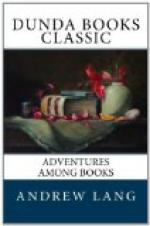Who was she? What did she want? Whence did she come? What was the horror she revealed to the night in the bower of Christabel?
“Then drawing in her breath
aloud
Like one that shuddered, she unbound
The cincture from beneath her breast.
Her silken robe and inner vest
Dropt to her feet, and full in view
Behold her bosom and half her side—
A sight to dream of, not to tell!
O shield her! shield sweet Christabel!”
And then what do her words mean?
“Thou knowest to-night, and
wilt know to-morrow,
This mark of my shame, this seal
of my sorrow.”
What was it—the “sight to dream of, not to tell?”
Coleridge never did tell, and, though he and Mr. Gilman said he knew, Wordsworth thought he did not know. He raised a spirit that he had not the spell to lay. In the Paradise of Poets has he discovered the secret? We only know that the mischief, whatever it may have been, was wrought.
“O sorrow and shame!
Can this be she—
The lady who knelt at the old oak
tree?”
. . .
“A star hath set, a star hath
risen,
O Geraldine, since
arms of thine
Have been the lovely lady’s
prison.
O Geraldine, one
hour was thine.” {11}
If Coleridge knew, why did he never tell? And yet he maintains that “in the very first conception of the tale, I had the whole present to my mind, with the wholeness no less than with the liveliness of a vision,” and he expected to finish the three remaining parts within the year. The year was 1816, the poem was begun in 1797, and finished, as far as it goes, in 1800. If Coleridge ever knew what he meant, he had time to forget. The chances are that his indolence, or his forgetfulness, was the making of “Christabel,” which remains a masterpiece of supernatural suggestion.
For description it suffices to read the “Ancient Mariner.” These marvels, truly, are speciosa miracula, and, unlike Southey, we believe as we read. “You have selected a passage fertile in unmeaning miracles,” Lamb wrote to Southey (1798), “but have passed by fifty passages as miraculous as the miracles they celebrate.” Lamb appears to have been almost alone in appreciating this masterpiece of supernatural description. Coleridge himself shrank from his own wonders, and wanted to call the piece “A Poet’s Reverie.” “It is as bad as Bottom the weaver’s declaration that he is not a lion, but only the scenical representation of a lion. What new idea is gained by this title but one subversive of all credit—which the tale should force upon us—of its truth?” Lamb himself was forced, by the temper of the time, to declare that he “disliked all the miraculous part of it,” as if it were not all miraculous! Wordsworth wanted the Mariner “to have a character and a profession,” perhaps would have liked him to be a gardener, or a butler, with “an excellent character!” In fact, the love of the supernatural was then at so low an ebb that a certain Mr. Marshall “went to sleep while the ‘Ancient Mariner’ was reading,” and the book was mainly bought by seafaring men, deceived by the title, and supposing that the “Ancient Mariner” was a nautical treatise.




